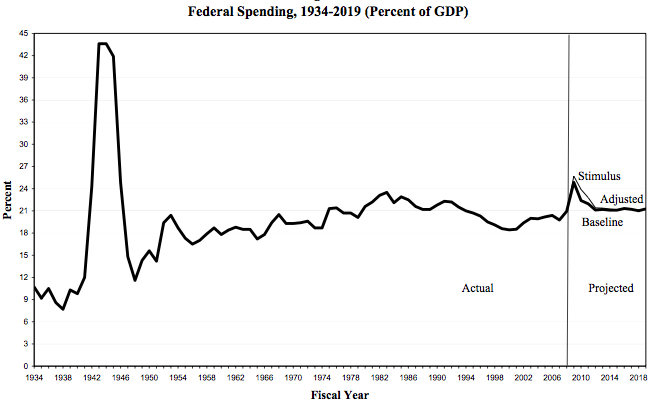Considering the graph below comparing the percent of GDP spent for economic stimulus during The Great Depression (1940s) and today (from the Tax Policy Center), Ezra Klein concludes:
We’re spending a lot right now, but this is hardly the most aggressive fiscal experiment in history.

Contrast that summation with this ad from the American Issues Project:
[youtube]https://www.youtube.com/watch?v=eZ_Chroi4oc[/youtube]
This is what sociologists call a framing war. Is the economic stimulus big or small? You can make arguments either way, and people will. The question is: Which frame will resonate more with (which members of) the American public? We’ll have to wait and see.
(Via Alas A Blog.)
Lisa Wade, PhD is an Associate Professor at Tulane University. She is the author of American Hookup, a book about college sexual culture; a textbook about gender; and a forthcoming introductory text: Terrible Magnificent Sociology. You can follow her on Twitter and Instagram.
Comments 7
Stimulus » FRAMING THE STIMULUS — February 21, 2009
[...] Sociological Images wrote an interesting post today on FRAMING THE STIMULUSHere’s a quick excerptby lisa onFeb 21, 2009 at 3:37 pm Considering the graph below comparing the percent of GDP spent for economic stimulus during The Great Depression (1940s) and today (from the Tax Policy Center), Ezra Klein concludes:We’re spending a lot right now, but this is hardly the most aggressive fiscal experiment in history.Contrast that summation with this ad from the American Issues Project:This is what sociologists call a framing war. Is the economic stimulus big or small? You can make arguments eit [...]
T B — February 21, 2009
On the one hand, there are different views about the quantity that will be spent; and, on the other hand, there are questions about where the money is going and what outcomes will result from the spending.
Of course, the graph only addresses the quantity of the spending.
Nathan — February 21, 2009
That spending spike is during WWII, not the Great Depression which actually happened in 1930's. There is debate about whether the New Deal or WWII ended the countries economic woes, but it makes no sense to compare the spending during WWII with Obama's stimulus plan.
Gwen Sharp, PhD — February 21, 2009
I see no reason that comparing WWII spending to a stimulus plan isn't valid. WWII was massive government spending; the cause of it certainly wasn't chosen by the U.S. government, but our decision to spend billions on it had a huge impact. We didn't have to spend so massively, but we did. That's a political decision, and few people today second-guess it.
Clayton — February 23, 2009
Gwen, it would still be more relevant to compare the current stimulus to New Deal spending. WWII was not remotely similar to traditional stimulus spending, and it is unfair to implicitly call it the "most aggressive fiscal experiment in history".
OP Minded — February 24, 2009
It's actually more a "spending bill" than a "stimulus bill". The concern is that there is simply not enough spending on that will create jobs and increase productivity. The downside to that is that after the money is spent, you still owe a huge bill because Obama is borrowing the money from the next generation for this spending bill.
Dubi — February 27, 2009
Is US spending on the wars in Iraq and Afghanistan also included in the data here?